The article by Raynard Churchwell first appeared on the Kennesaw State University website, republished with permission
The National Highway Traffic Safety Administration reports that more than 40,000 people died last year in vehicle crashes across the United States, many of those accidents being preventable. To improve roadway safety for motorists everywhere, Kennesaw State University researchers are studying how existing technology can be used to reduce collisions and save lives.
Billy Kihei, an assistant professor of computer engineering in the Southern Polytechnic College of Engineering and Engineering Technology, is leading a National Science Foundation (NSF)-sponsored research initiative that seeks to improve vehicle safety through cutting-edge sensing and communication technologies. The project focuses on Cellular Vehicle-to-Everything (C-V2X) technology, which allows vehicles to communicate directly with each other, potentially reducing up to 80% of crashes involving non-impaired drivers.
As the United States prepares to roll out the largest wireless communications technology for automotive safety, many vehicles on the road still lack this advanced technology. To address this challenge, Kihei’s team is exploring how C-V2X can be utilized to detect vehicles not equipped with the technology, using an approach known as integrated sensing and communications (ISAC).
“The concept is to use the signal from C-V2X to passively sense the environment around the vehicle,” Kihei said. “This enables the vehicle to detect potential collisions even if it is the only one transmitting.”
The research unfolds in several key stages. Initially, the focus is on theoretical analysis and the development of models to understand how C-V2X signals can be utilized for passive sensing. In this stage, they work on developing and improving simulations that can use these signals to detect obstacles and other vehicles.
Following the theoretical groundwork, the project advances to practical implementation. This phase involves setting up experiments and simulations with real-world data. The research team, including Ph.D. students and undergraduate researchers from the engineering college, builds and tests prototypes of the sensing system. The research findings will guide further refinements and expand the system’s potential applications to next-generation cellular networks and next-generation Wi-Fi.
“We are initially focused on preventing rear-end collisions. Our iterative approach ensures that the technology is refined and optimized to meet diverse needs and perform effectively in various other driving situations.” Kihei said.
The project is closely aligned with KSU’s new Ph.D. in Interdisciplinary Engineering, which focuses on integrating multiple disciplines to tackle complex problems. This research not only demonstrates the benefits of interdisciplinary collaboration but also provides students with valuable hands-on experience in groundbreaking technology.
Kihei’s work seeks to overcome significant integration challenges and advance the field of joint wireless communication and sensing technologies.
“This research addresses current challenges and sets the stage for the future of automotive safety and technology,” Kihei said. “By integrating new systems with existing infrastructure, we are paving the way for advancements that will enhance road safety and technology efficiency in the years ahead.”
Travis Stanca, a KSU graduate involved in preliminary studies of this research, expressed his excitement being a part of the research.
“Being part of this project has been an amazing experience,” Stanca said. “This work will significantly enhance vehicle safety by providing crucial information for obstacle detection and future vehicle autonomy.”
